CHEVROLET CORVETTE 1994 4.G Owner's Guide
Manufacturer: CHEVROLET, Model Year: 1994, Model line: CORVETTE, Model: CHEVROLET CORVETTE 1994 4.GPages: 274, PDF Size: 15.61 MB
Page 31 of 274
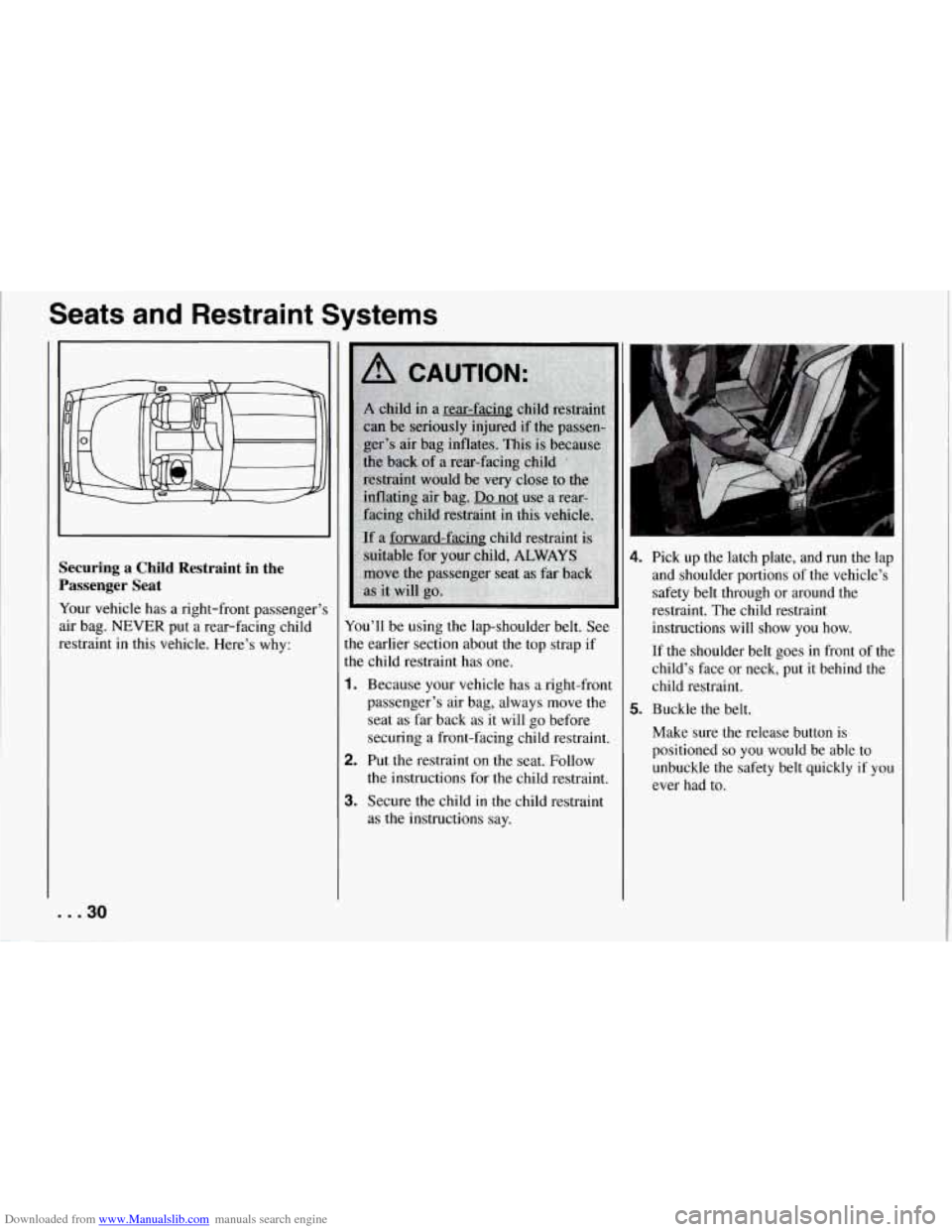
Downloaded from www.Manualslib.com manuals search engine Seats and Restraint Systems
Securing a Child Restraint in the
Passenger Seat
Your vehicle has a right-front passenger’s
air bag.
NEVER put a rear-facing child
restraint in this vehicle. Here’s why:
... 30
You’ll be using the lap-shoulder belt. See
the earlier section about the top strap if
the child restraint has one.
1. Because your vehicle has a right-front
passenger’s air bag, always move the
seat as far back as it will go before
securing a front-facing child restraint.
2. Put the restraint on the seat. Follow
the instructions for the child restraint.
3. Secure the child in the child restraint
as the instructions say.
4. Pick up the latch plate, and run the lap
and shoulder portions of the vehicle’s
safety belt through or around the
restraint. The child restraint instructions will show you how.
If the shoulder belt goes in front of the
child’s face or neck, put it behind the
child restraint.
5. Buckle the belt.
Make sure the release button is
positioned
so you would be able to
unbuckle the safety belt quickly if you
ever had to.
Page 32 of 274
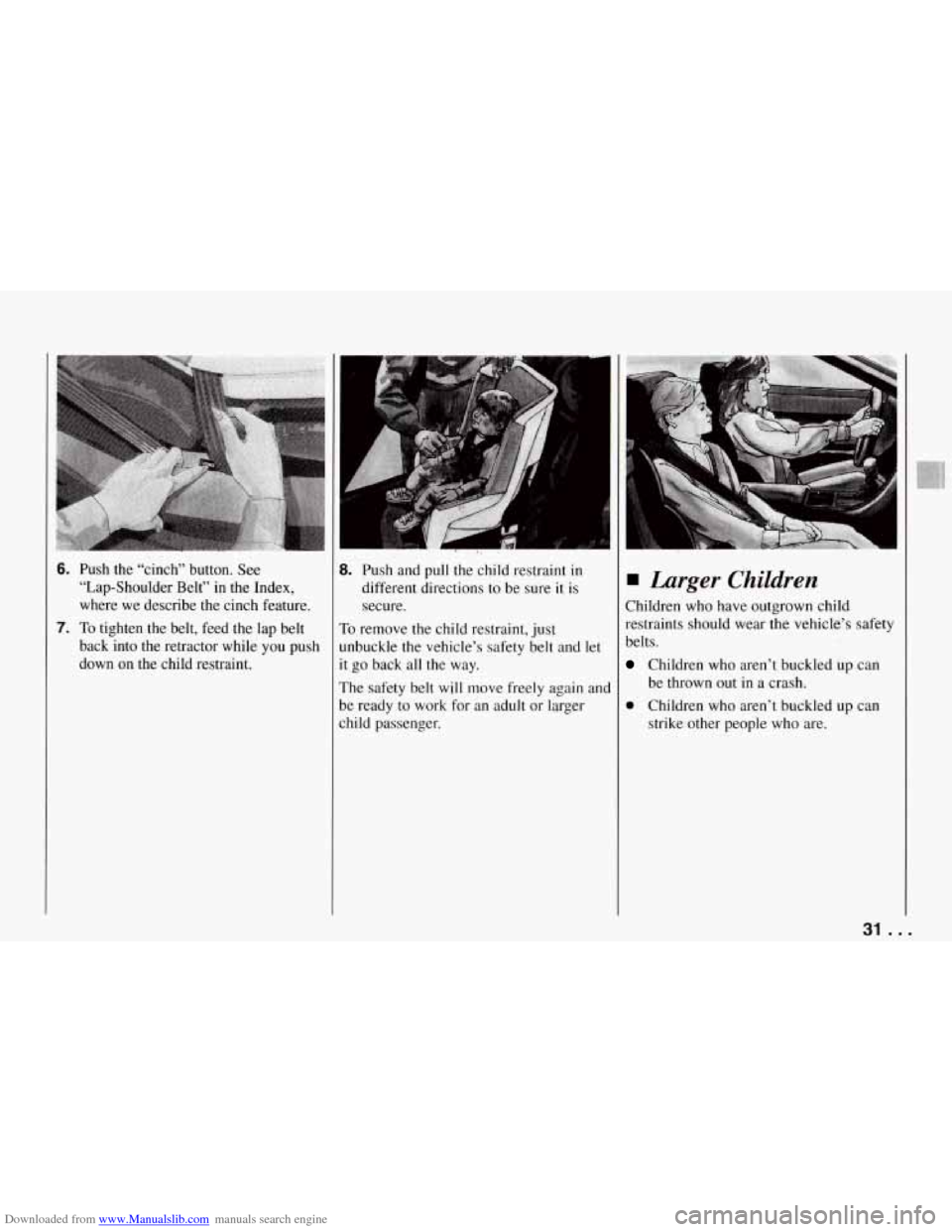
Downloaded from www.Manualslib.com manuals search engine 6. Push the “cinch” button. See
“Lap-Shoulder Belt” in the Index,
where we describe the cinch feature.
7. To tighten the belt, feed the lap belt
back into the retractor while you push down on the child restraint.
8. Push and pull the child restraint in
different directions to be sure
it is
secure.
To remove the child restraint, just
unbuckle the vehicle’s safety belt and let
it go back all the way.
The safety belt
will move freely again and
be ready to work for an adult or larger
child passenger.
Larger Children
Children who have outgrown child
restraints should wear the vehicle’s safety
belts.
Children who aren’t buckled up can
0 Children who aren’t buckled up can
be thrown
out
in a crash.
strike other people who are.
31 ...
Page 33 of 274
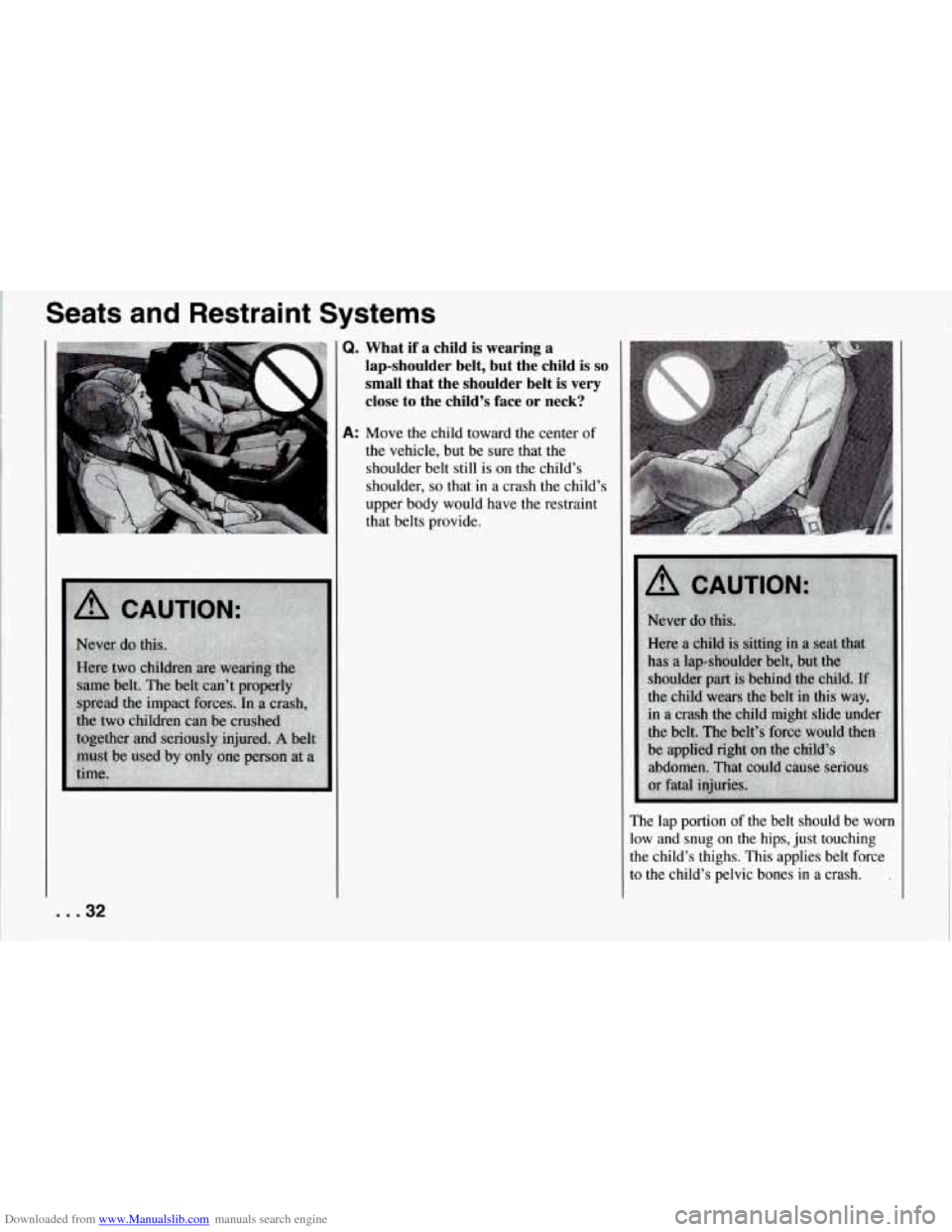
Downloaded from www.Manualslib.com manuals search engine Seats and Restraint Systems
Q. What if a child is wearing a
lap-shoulder belt, but the child
is so
small that the shoulder belt is very
close to the child’s face
or neck?
A: Move the child toward the center of
the vehicle, but be sure that the
shoulder belt still
is on the child’s
shoulder,
so that in a crash the child’s
upper body would have the restraint
that belts provide.
The lap portion of the belt should be worn
low and snug on the hips, just touching
the child’s thighs. This applies belt force
to the child’s pelvic bones in a crash.
.
... 32
Page 34 of 274
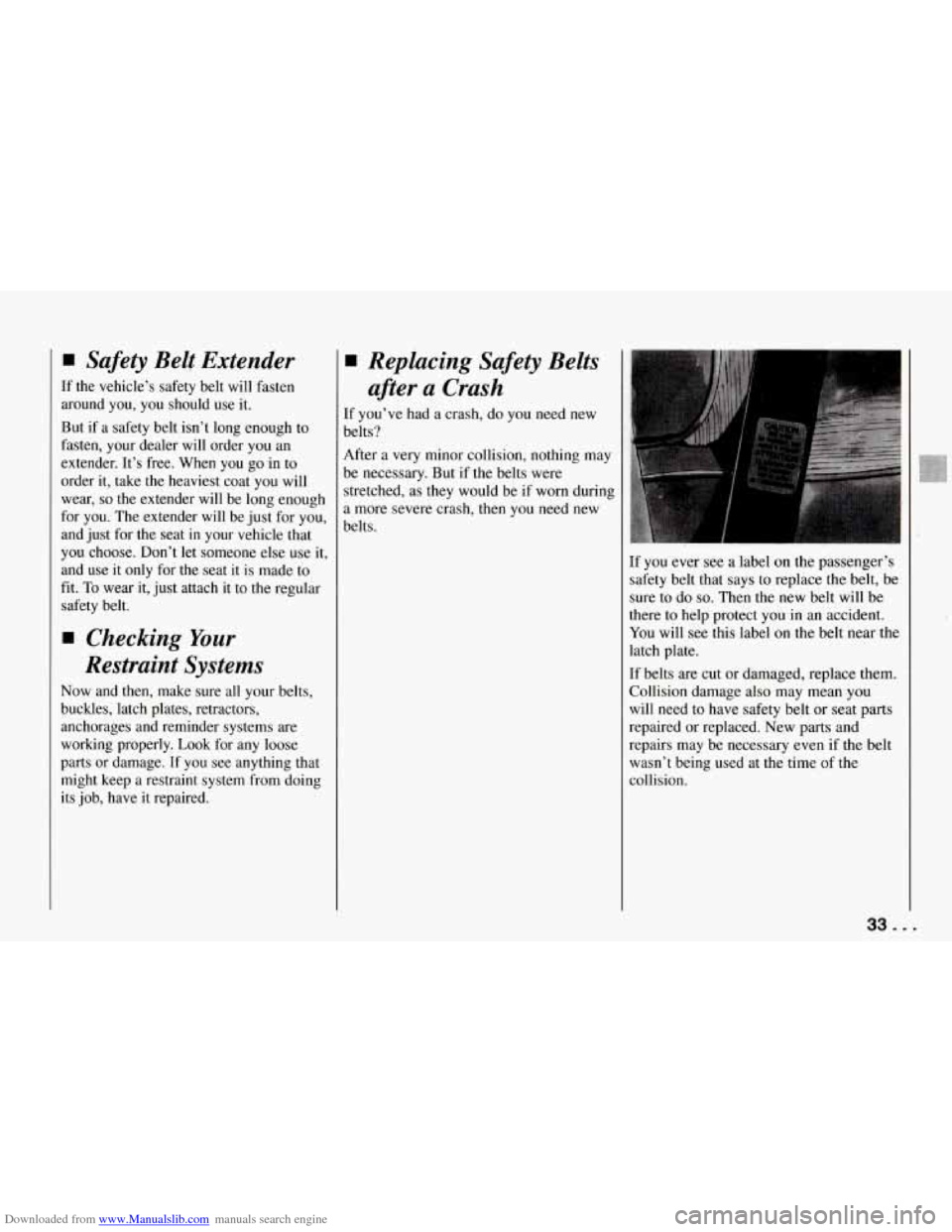
Downloaded from www.Manualslib.com manuals search engine Safety Belt Extender
If the vehicle’s safety belt will fasten
around you, you should use it.
But if a safety belt isn’t long enough to
fasten, your dealer will order you an
extender. It’s free. When you go in to
order it, take the heaviest coat you will
wear,
so the extender will be long enough
for you. The extender will be just for you,
and just for the seat in your vehicle that
you choose. Don’t let someone else use it,
and use it only for the seat it is made to
fit. To wear it, just attach it to the regular
safety belt.
Checking Your
Restraint Systems
Now and then, make sure all your belts,
buckles, latch plates, retractors,
anchorages and reminder systems are
working properly.
Look for any loose
parts
or damage. If you see anything that
might keep a restraint system from doing
its job, have it repaired.
Replacing Safety Belts
after
a Crash
[f you’ve had a crash, do you need new
selts?
4fter a very minor collision, nothing may
3e necessary. But if the belts were
stretched, as they would be if worn during
I more severe crash, then you need new
3elts.
rf yo1
.I ever see a label on the passenger’s
safety belt that says to replace the belt, be
sure to do
so. Then the new belt will be
there to help protect you in an accident.
You will see this label on the belt near the
latch plate.
If belts are cut
or damaged, replace them.
Collision damage also may mean. you
will need to have safety belt
or seat parts
repaired or replaced. New parts and
repairs may be necessary even if the belt
wasn’t being used at the time of the
collision.
33 ...
Page 35 of 274
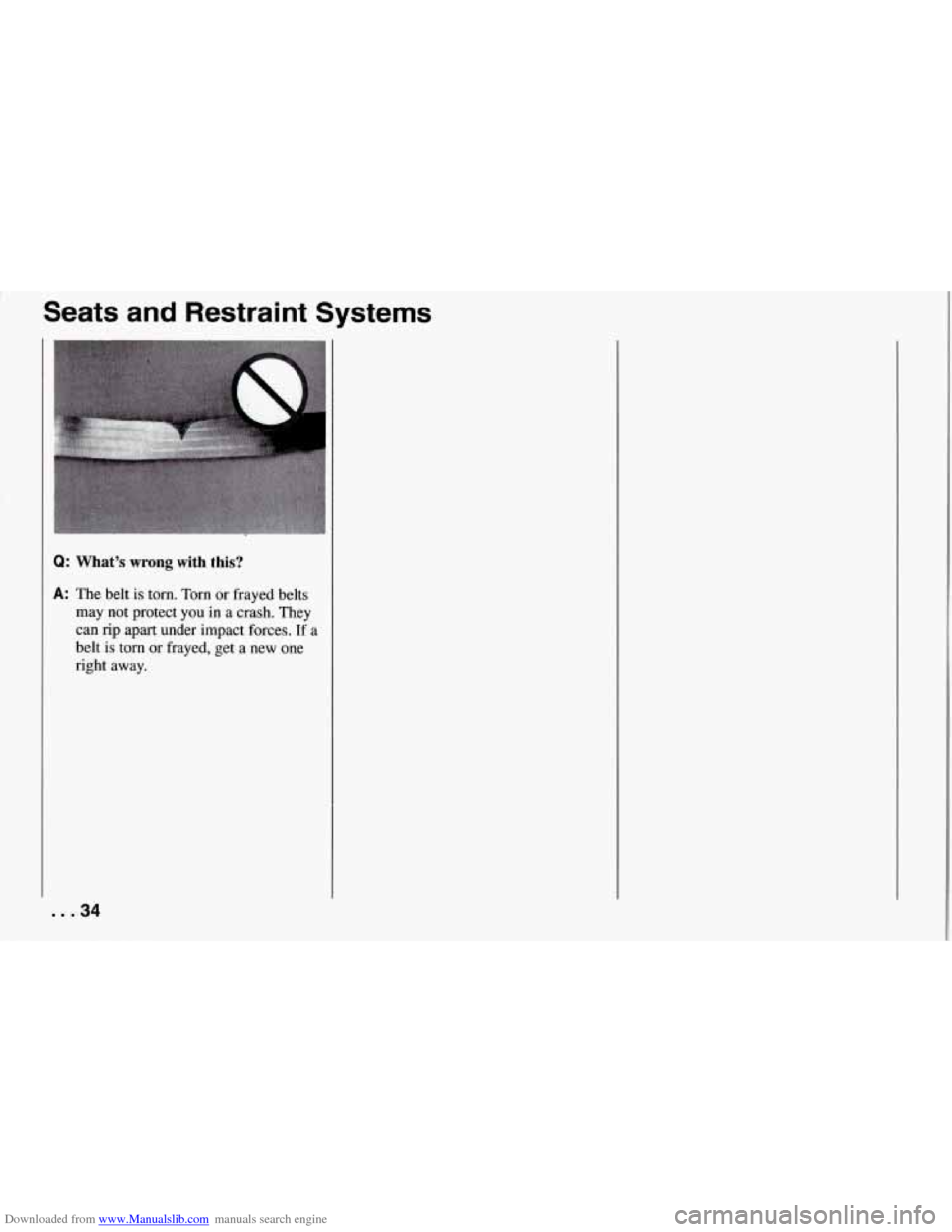
Downloaded from www.Manualslib.com manuals search engine Seats and Restraint Systems
Q: What’s wrong with this?
A: The belt is torn. Torn or frayed belts
may not protect you
in a crash. They
can rip apart under impact forces.
If a
belt
is torn or frayed, get a new one
right away.
... 34
Page 36 of 274
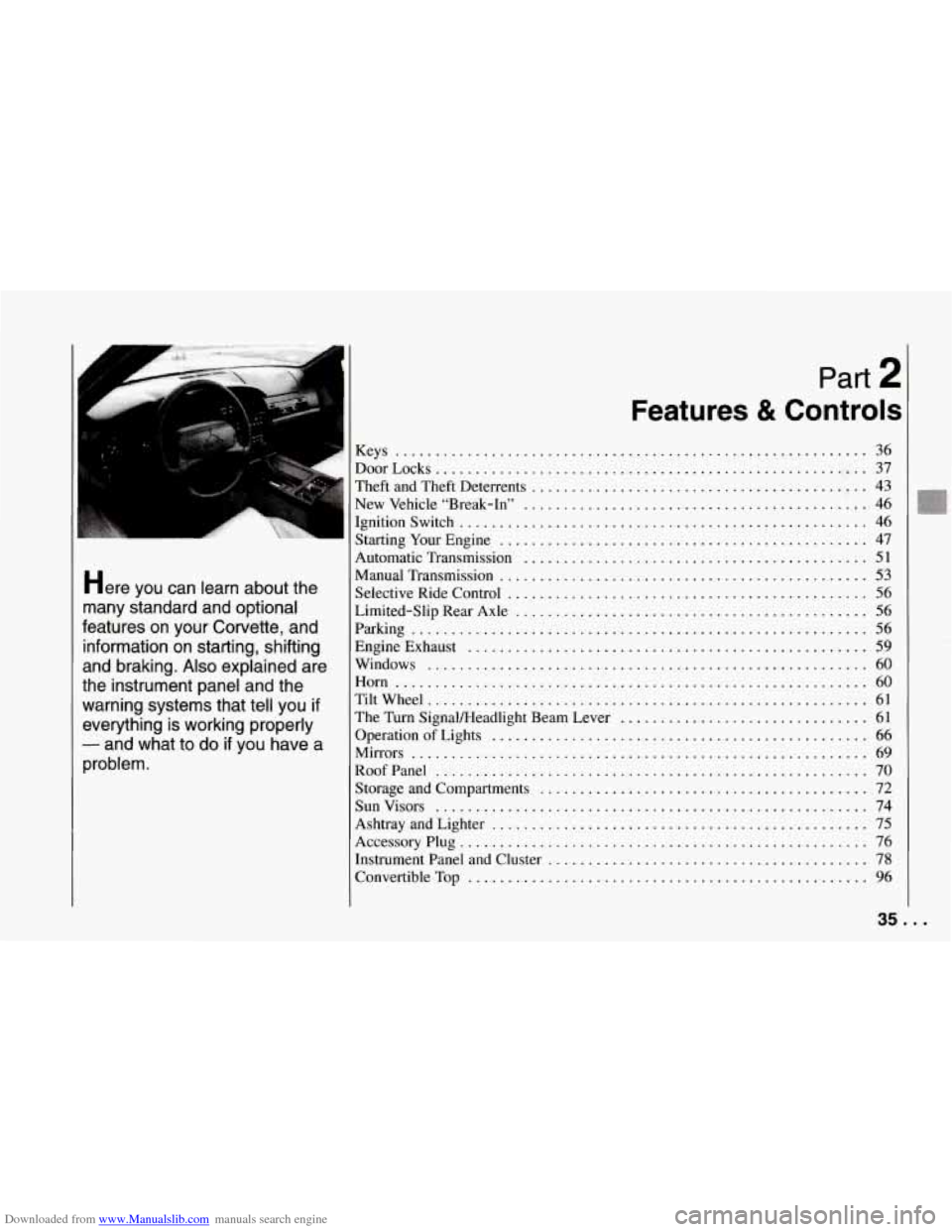
Downloaded from www.Manualslib.com manuals search engine A
Part 2
Features & Controls
Keys ........................................................... 36
DoorLocks
...................................................... 37
Theft and Theft Deterrents
.......................................... 43
New Vehicle “Break-In”
........................................... 46
IIgnitionSwitch
................................................... 46
Starting Your Engine
.............................................. 47
Automatic Transmission
........................................... 51
Manual Transmission
.............................................. 53
many standard and optional Limited-Slip Rear Axle ............................................ 56
Parking 56
Here You can learn d3out the Selective Ride Control ............................................. 56
features on your Corvette. and .........................................................
information on starting. shifting Engine Exhaust .................................................. 59
and braking . Also explained are Windows ....................................................... 60
........................................................... the instrument panel and the Horn 60
warning systems that tell you if Tiltwheel 61
everything is working properly The Turn SignaVHeadlight Beam Lever 61
- and what to do if you have a OperationofLights 66
Mirrors
......................................................... 69 problem . RoofPanel ...................................................... 70
Sunvisors
...................................................... 74
.......................................................
...............................
...............................................
Storage and Compartments ......................................... 72
Ashtray and Lighter
............................................... 75
Accessory Plug
................................................... 76
Instrument Panel and Cluster
........................................ 78
ConvertibleTop
.................................................. 96
35 ...
Page 37 of 274
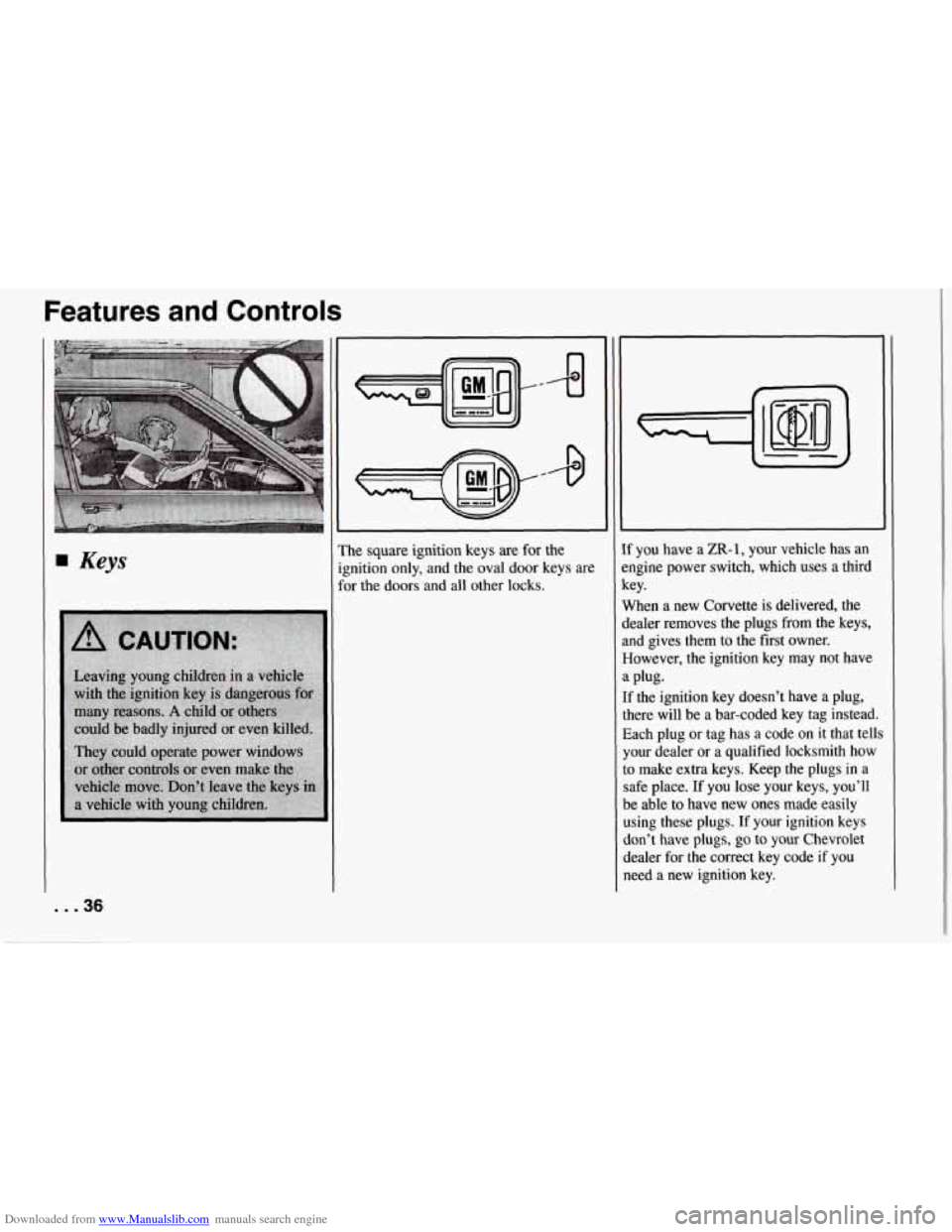
Downloaded from www.Manualslib.com manuals search engine Features and Controls
Keys
. . .36
W
’he square ignition keys are for the
;nition only, and the oval door keys are
x the doors and all other locks.
F you have a ZR- 1, your vehicle has an
ngine power switch, which uses a third
ley.
Yhen a new Corvette is delivered, the
lealer removes the plugs from the keys,
ad gives them to the first owner.
lowever,
the ignition key may not have
f the ignition key doesn’t have a plug,
here will be a bar-coded key tag instead.
3ach plug or tag has a code on it that tells
‘our dealer or a qualified locksmith
how
o make extra keys. Keep the plugs in a
‘afe place.
If you lose your keys, you’ll
,e able to have new ones made easily
lsing these plugs.
If your ignition keys
lon’t have plugs, go to your Chevrolet
lealer for the correct key code if you
leed a new ignition key.
. plug.
Page 38 of 274
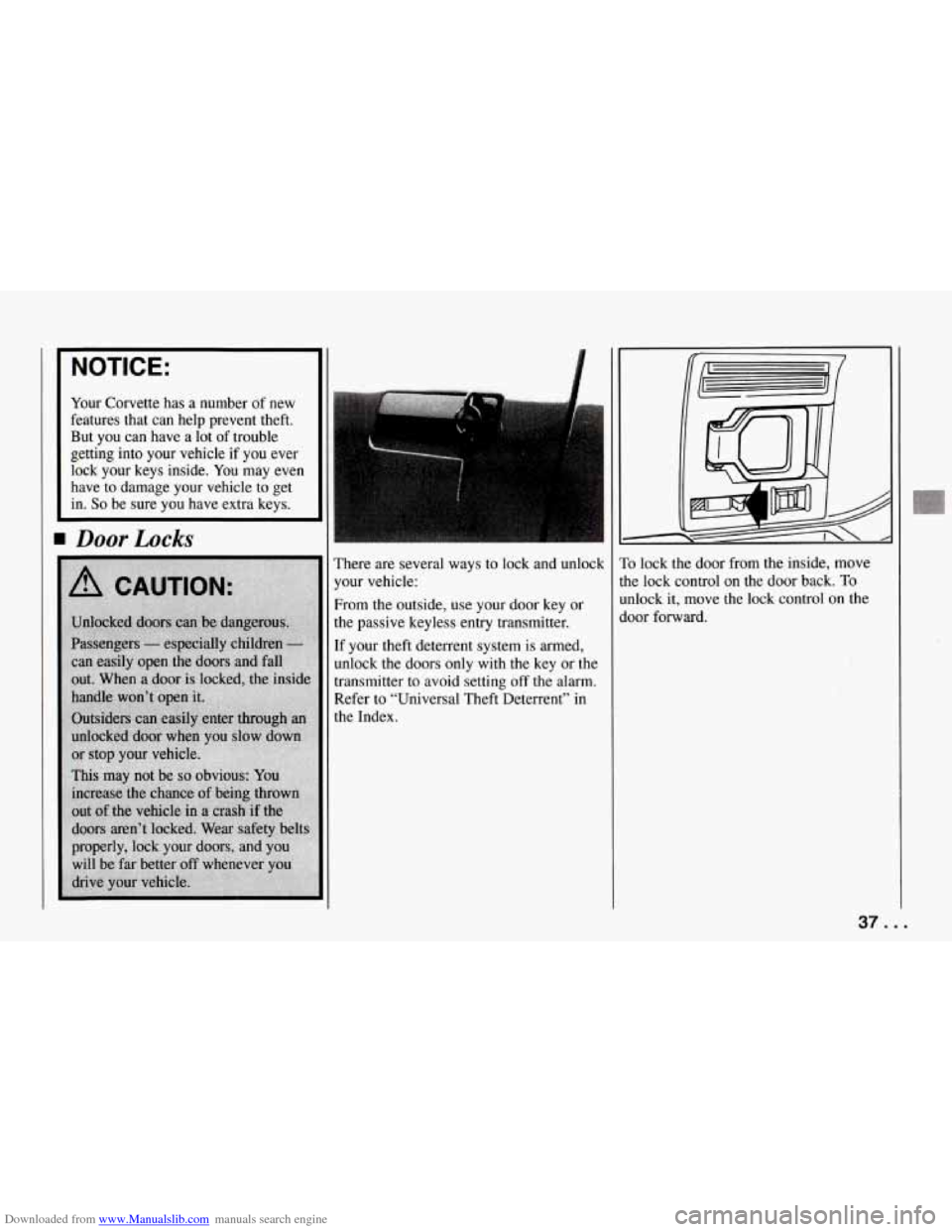
Downloaded from www.Manualslib.com manuals search engine NOTICE:
Your Corvette has a number of new
features that can help prevent theft.
But you can have a lot
of trouble
getting into your vehicle
if you ever
lock your keys inside. You may even
have to damage your vehicle to get
in. So be sure you have extra keys.
Door Locks
There are several ways to lock and unlock
your vehicle:
From the outside, use your door key or
the passive keyless entry transmitter.
If your theft deterrent system
is armed,
unlock the doors only with the key or the
transmitter to avoid setting off the alarm.
Refer to “Universal Theft Deterrent” in
the Index.
To lock the door from the inside, move
the lock control
on the door back. To
unlock
it, move the lock control on the
door forward.
37 ...
Page 39 of 274
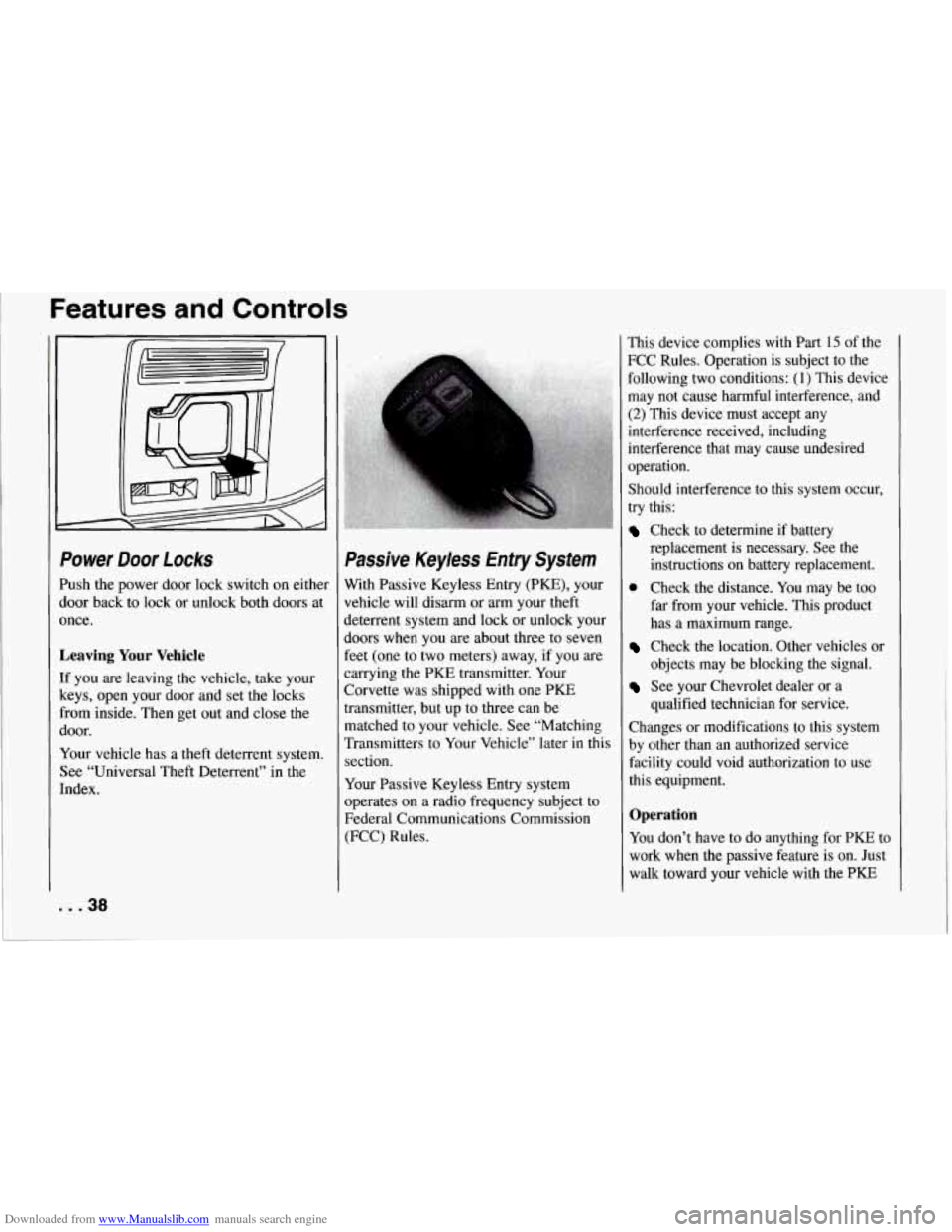
Downloaded from www.Manualslib.com manuals search engine Features and Controls
Power Door Locks
Push the power door lock switch on either
door back to lock or unlock both doors at
once.
Leaving Your Vehicle
If you are leaving the vehicle, take your
keys, open your door and set the locks
from inside. Then get out and close the
door.
Your vehicle has a theft deterrent system.
See “Universal Theft Deterrent” in the
Index.
Passive Keyless Entry System
With Passive Keyless Entry (PJSE), your
vehicle will disarm or
arm your theft
deterrent system and lock or unlock your
doors when you are about three to seven
feet (one to two meters) away, if you are
carrying the PKE transmitter. Your
Corvette was shipped with one
PKE
transmitter, but up to three can be
matched to your vehicle. See “Matching
Transmitters to Your Vehicle” later in this
section.
Your Passive Keyless Entry system
operates on a radio frequency subject to
Federal Communications Commission
(FCC) Rules. This
device complies with
Part 15 of the
FCC Rules. Operation is subject to the
following two conditions: (1) This device
may not cause harmful interference, and
(2) This device must accept any
interference received, including
interference that may cause undesired
operation.
Should interference to this system occur,
try this:
Check to determine if battery
replacement is necessary. See the
instructions on battery replacement.
Check the distance. You may be too
far from your vehicle. This product
has
a maximum range.
Check the location. Other vehicles or
objects may be blocking the signal.
See your Chevrolet dealer or a
qualified technician for service.
Changes or modifications to this system
by other than an authorized service
facility could void authorization to use this equipment.
Operation
You don’t have to do anything for PKE to
work when the passive feature
is on. Just
walk toward your vehicle with the PKE
... 38
Page 40 of 274
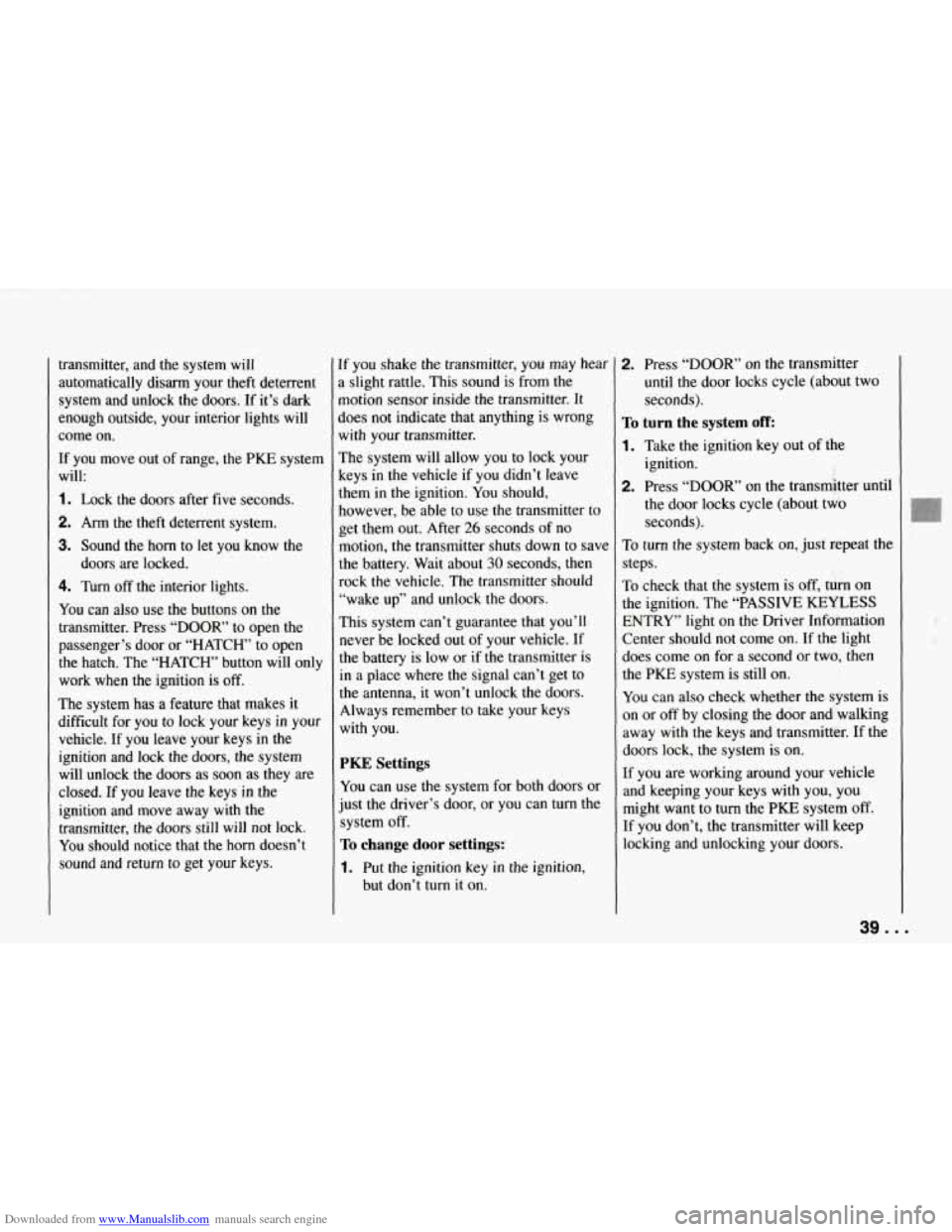
Downloaded from www.Manualslib.com manuals search engine transmitter, and the system will automatically disarm your theft deterrent
system and unlock the doors. If it’s dark
enough outside, your interior lights will
come on.
If you move out of range, the PKE system
will:
1. Lock the doors after five seconds.
2. Arm the theft deterrent system.
3. Sound the horn to let you know the
4. Turn off the interior lights.
You can also use the buttons on the
transmitter. Press
“DOOR’ to open the
passenger’s door or “HATCH’ to open
the hatch. The “HATCH’ button will only
work when the ignition is
off.
The system has a feature that makes it
difficult for you to lock your keys in your
vehicle. If you leave your keys in the
ignition and lock the doors,
the system
will unlock the doors as soon as they are
closed. If you leave
the keys in the
ignition and move away with the
transmitter, the doors still
will not lock.
You should notice that the horn doesn’t
sound and return to get your keys.
doors
are locked.
[f you shake the transmitter, you may hear
1 slight rattle. This sound is from the
notion sensor inside
the transmitter. It
joes not indicate that anything is wrong
with your transmitter.
The system will allow you to lock your
keys in
the vehicle if you didn’t leave
them in the ignition.
You should,
however, be able to use
the transmitter to
get them out. After
26 seconds of no
motion, the transmitter shuts down to save
the battery. Wait about
30 seconds, then
rock the vehicle. The transmitter should
”wake
up” and unlock the doors.
This system can’t guarantee that you’ll
never be locked out of your vehicle. If
the battery is low or if
the transmitter is
in a place where the signal can’t get to
the antenna, it won’t unlock the doors.
Always remember to take your keys
with you.
PKE Settings
You can use the system for both doors or
just the driver’s door, or you can
turn the
system
off.
To change door settings:
1. Put the ignition key in the ignition,
but don’t
turn it on.
2. Press “DOOR” on the transmitter
until the door locks cycle (about two
seconds).
To turn the system off:
1. Take the ignition key out of the
2. Press “DOOR’ on the transmitter unti
ignition.
the door locks cycle (about two
seconds).
To turn the system back on, just repeat the
steps.
To check that the system is off, turn on
the ignition. The “PASSIVE KEYLESS
ENTRY” light on the Driver Information
Center should not come on. If the light
does come on for a second or two, then
the PKE system is still on.
You can also check whether the system is
on or
off by closing the door and walking
away with the keys and transmitter.
If the
doors lock, the system is on.
If you are working around your vehicle
and keeping your keys with you, you
might want to turn the PKE system
off.
If you don’t, the transmitter will keep
locking and unlocking your doors.
39 . I